|
1. This tutorial will go over how to add categories and items to a weighted gradebook. If you have not gone through the Setup Wizard to setup your gradebook, click the link to access that tutorial. https://ior.ad/8yHB

|
|
2. Adding categories will allow you to assign percentages to each category. Adding items will give you a column in your gradebook to record grades. To continue, click Grades from the navigation menu.
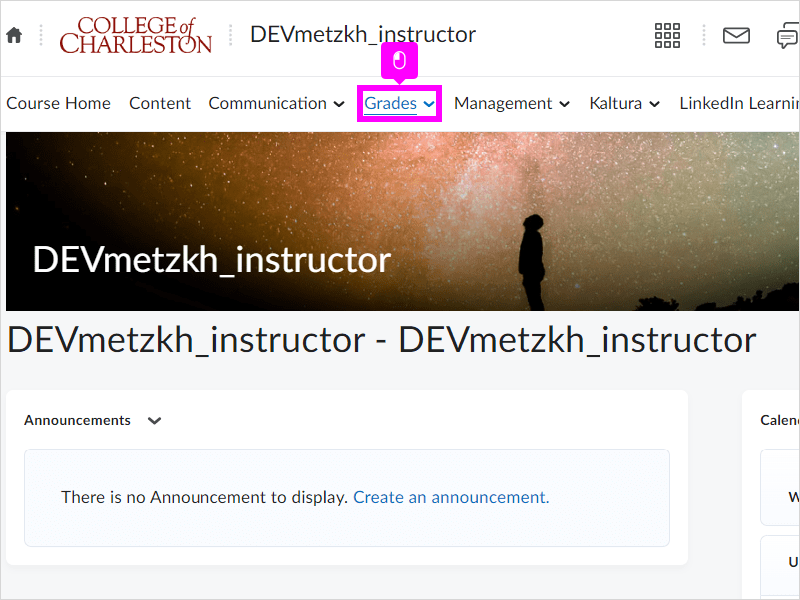
|
|
3. Click Grades in the drop-down menu.
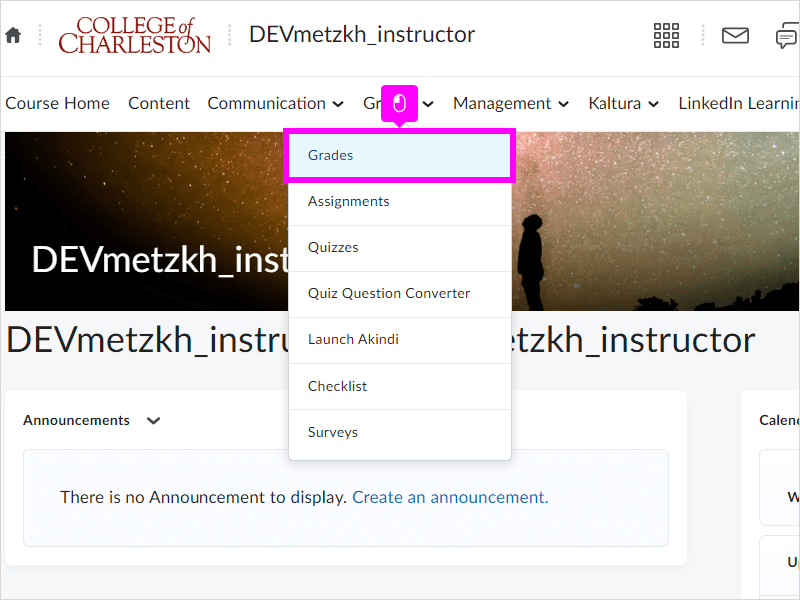
|
|
4. Click Manage Grades.

|
5. The Manage Grades area is where you set up your categories, percentages, and items. Examples of categories include things like Quizzes, Assignments, Tests, Homework, etc. Examples of items include things like Quiz 1, Chapter 2 Test, Assignment 4, etc
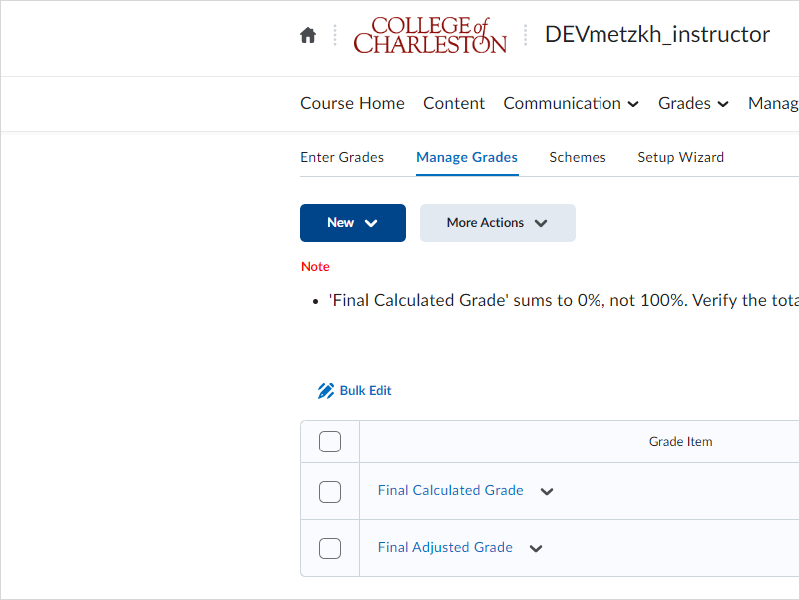
Explanation of categories and items.
The Manage Grades area is where you set up your categories, percentages, and items. Examples of categories include things like Quizzes, Assignments, Tests, Homework, etc. Examples of items include things like Quiz 1, Chapter 2 Test, Assignment 4, etc.
|
6. A category will contain like items. Creating an item is what will create a column in your gradebook. Categories are used to group items that have the same percentage. You can also drop the lowest grade(s) when you have your items in a category.
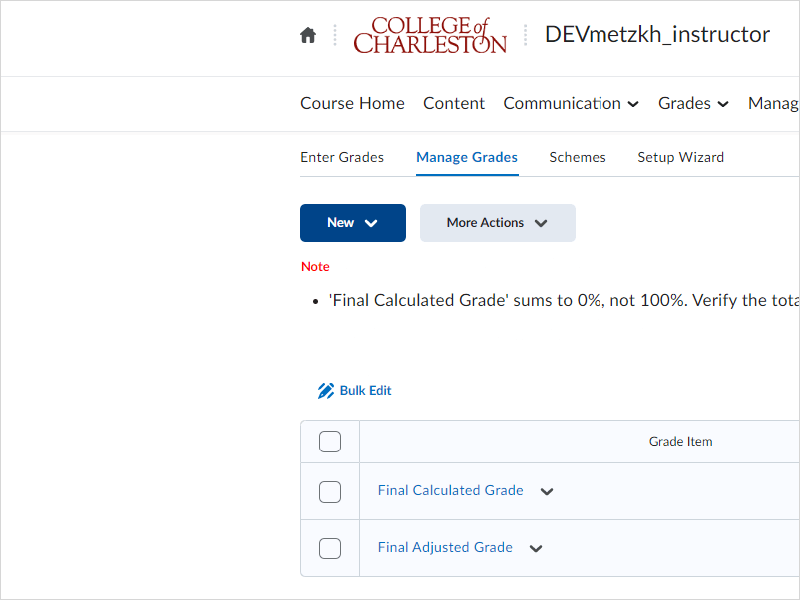
Explanation of categories and items.
A category will contain like items. Creating an item is what will create a column in your gradebook. Categories are used to group items that have the same percentage. You can also drop the lowest grade(s) when you have your items in a category.
|
7. In this tutorial, we will make an example gradebook that sets quizzes at 20%, assignments at 40%, a midterm exam at 20%, and a final exam at 20%.
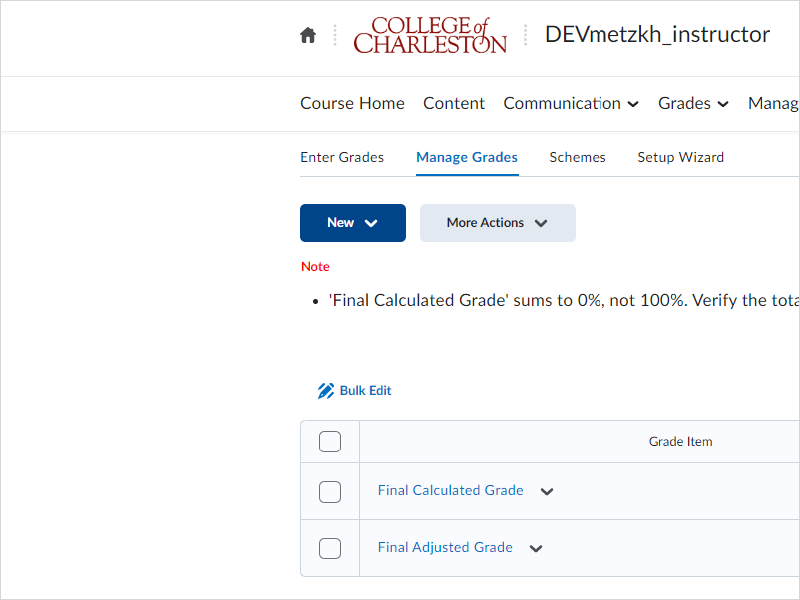
An example gradebook
In this tutorial, we will make an example gradebook that sets quizzes at 20%, assignments at 40%, a midterm exam at 20%, and a final exam at 20%.
|
|
8. Click on the New button.
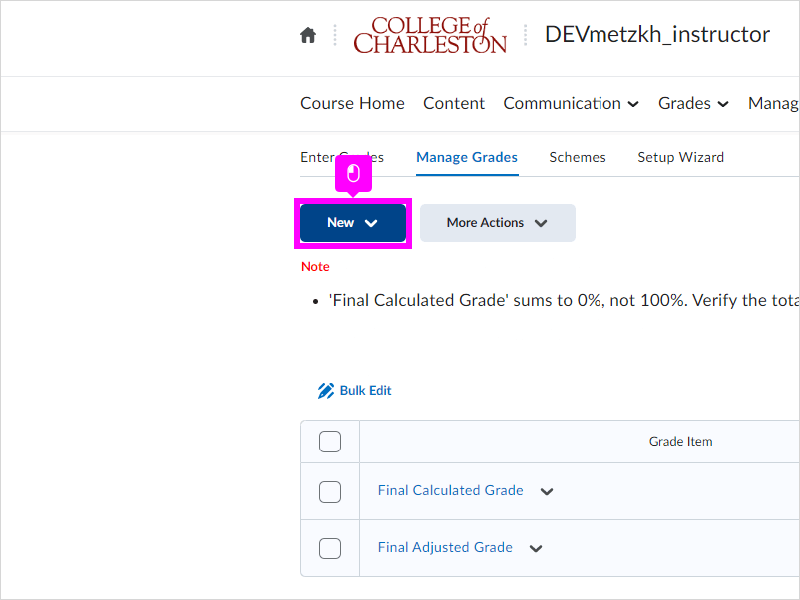
|
|
9. First, we'll set up our categories. For this example, we said we will have the categories of quizzes and assignments. To create a new category, click Category.
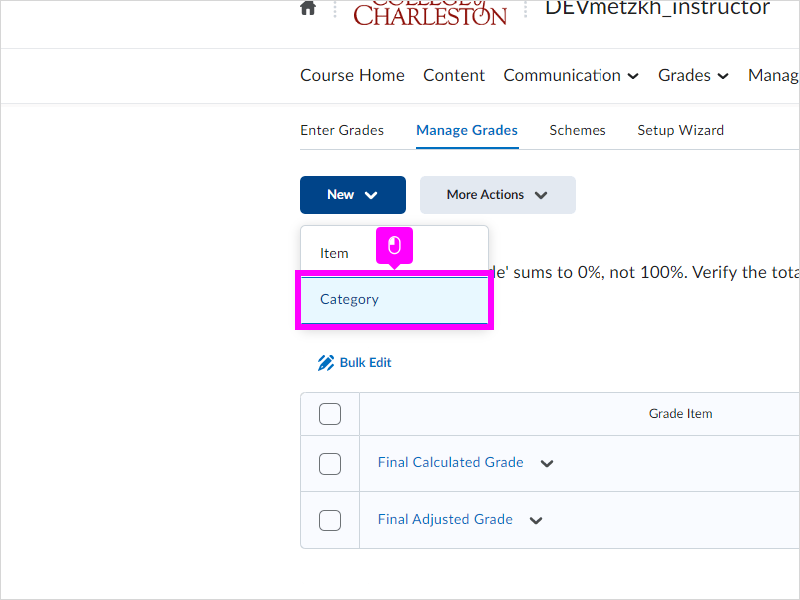
|
|
10. Let's create the Quizzes category. Type Quizzes into the Name field. You do not need to put anything in the Short Name or Description fields, unless you want to.
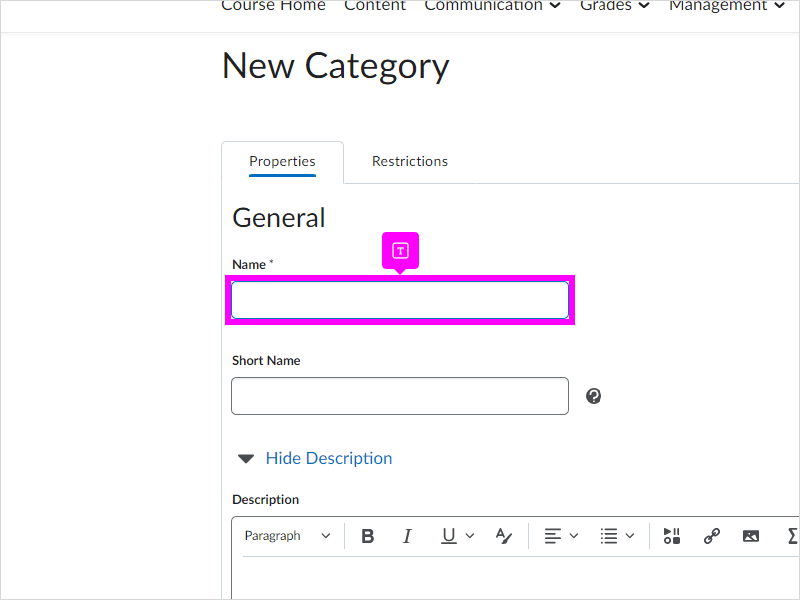
|
|
11. We said the Quizzes in our example would be worth 20%, so in the Weight field, type 20.
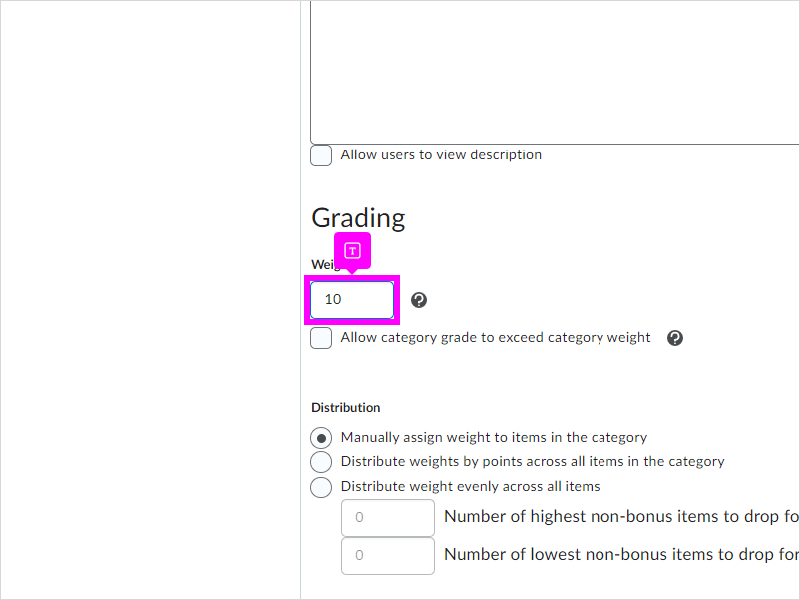
|
|
12. Decide how to distribute the weight of your items. Typically, the weight is distributed evenly across all items in a weighted gradebook. For this tutorial, click Distribute weight evenly across all items.
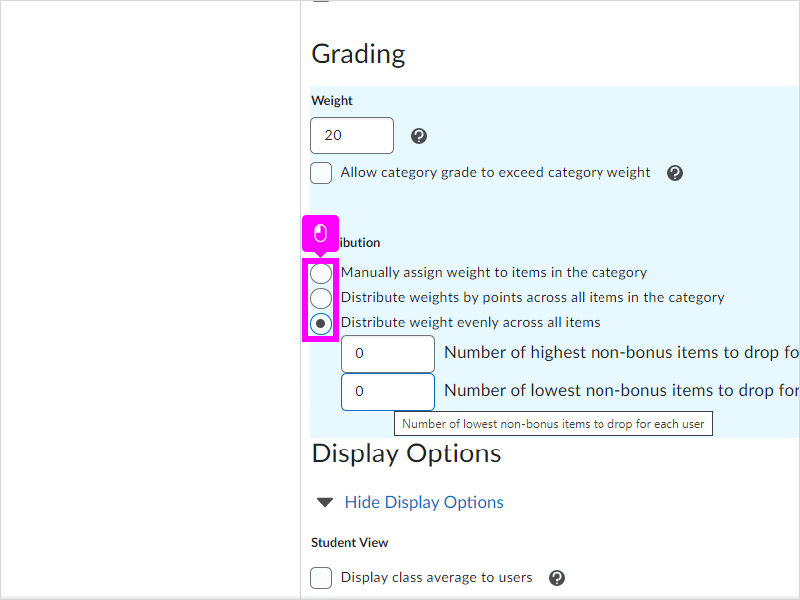
|
|
13. In this example, we will also drop the lowest quiz grade in the quizzes category, so type a 1 in that field.
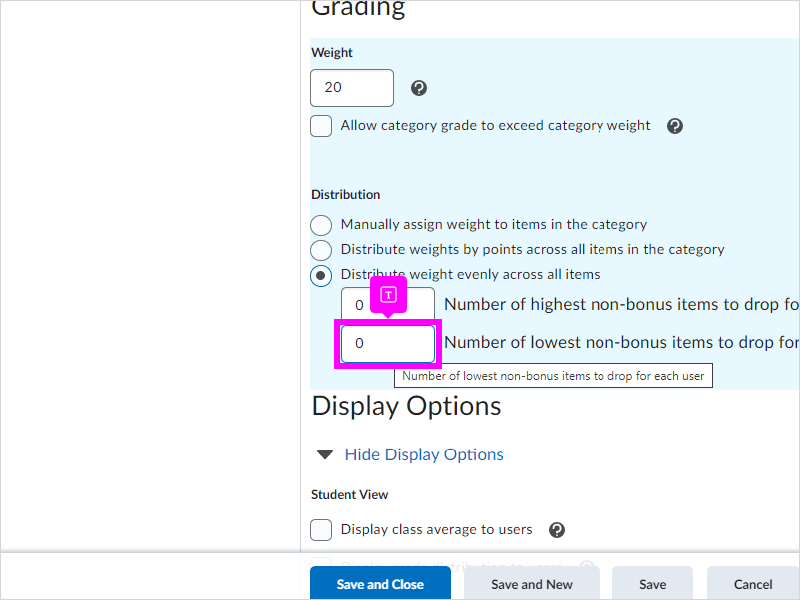
|
|
14. Click Save and New to create another category. If you did not need to create another category, you would click Save and Close.
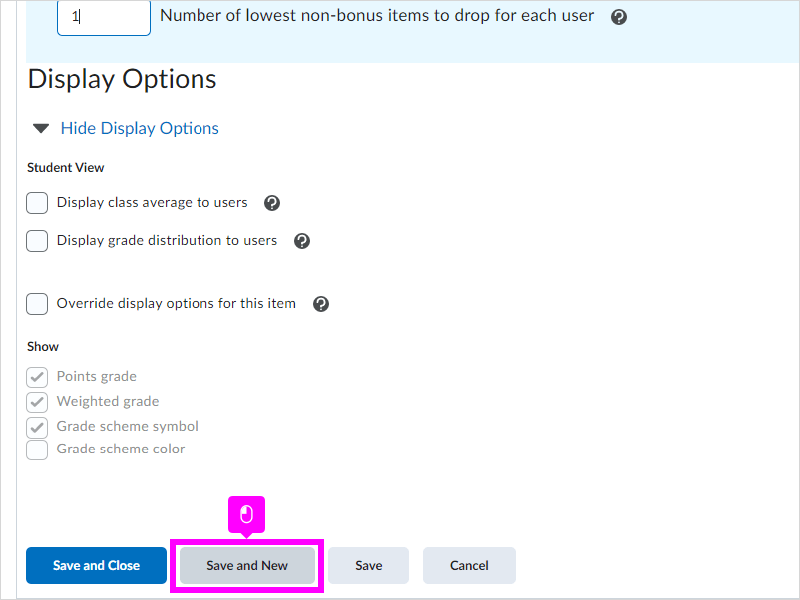
|
|
15. Now we will create the Assignments category in the same way. Type Assignments into the Name field. You do not need to put anything in the Short Name or Description fields unless you wanted to.
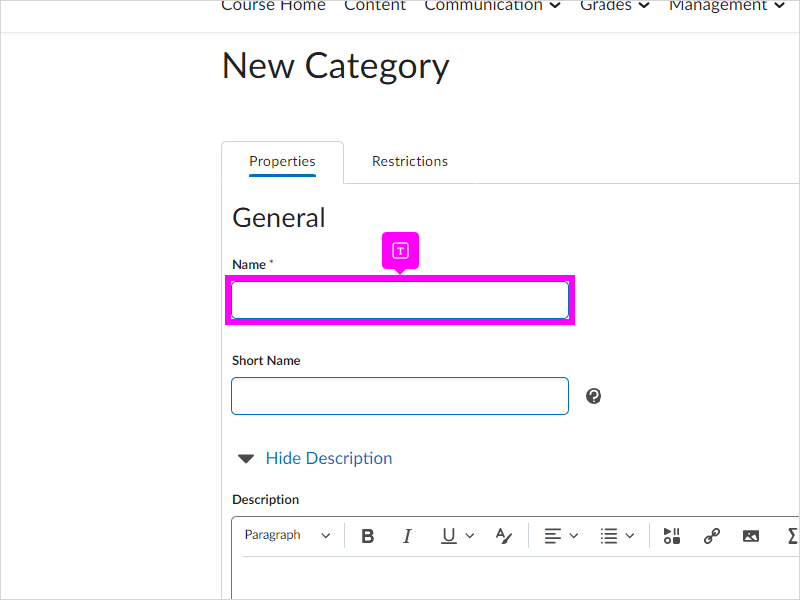
|
|
16. We said the Assignments in our example would be worth 40%, so in the Weight field, type 40.
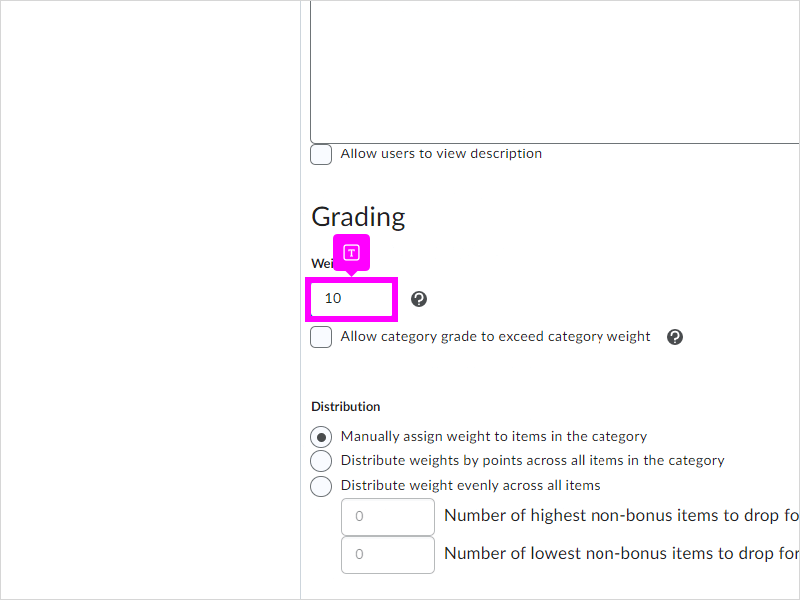
|
|
17. We will choose to distribute weight evenly across all items again, but we aren't going to drop any of the lowest scores in the Assignments categories so we leave that set at 0. For this tutorial, click Distribute weight evenly across all items.
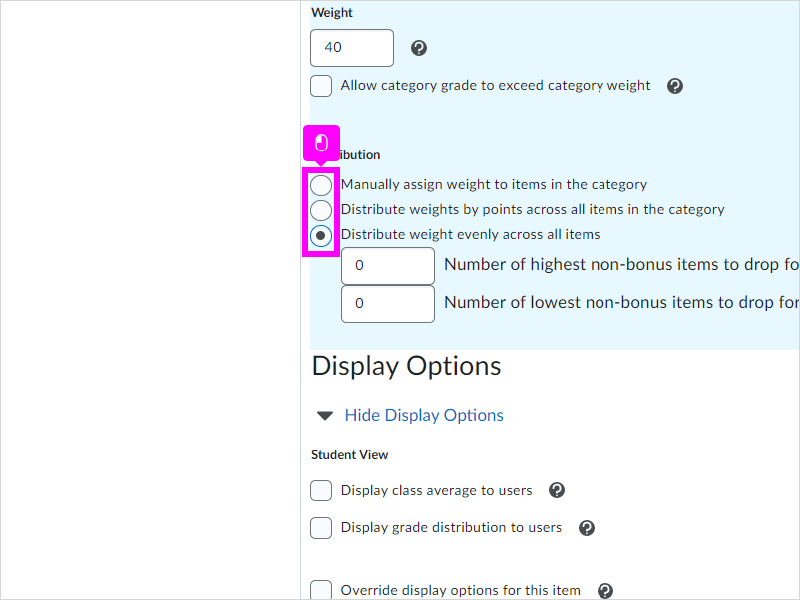
|
|
18. Click Save and Close.
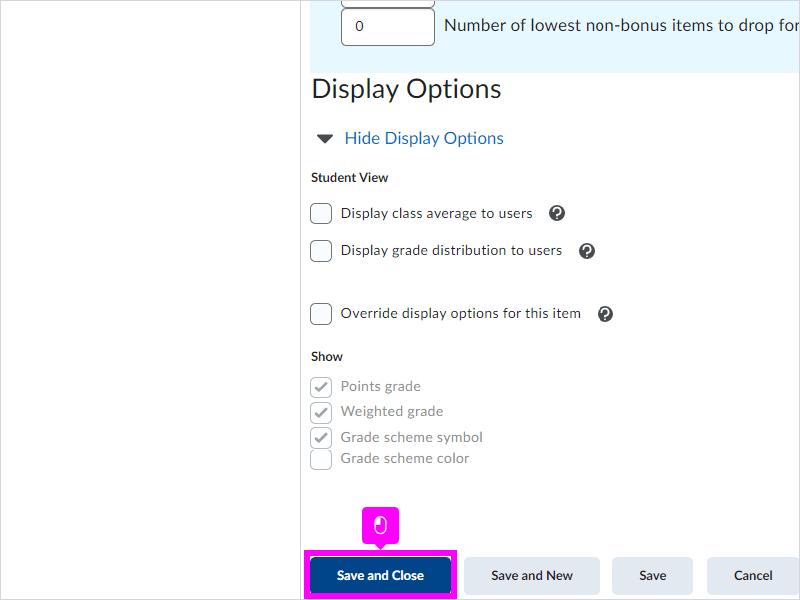
|
|
19. Now we will create our midterm exam. Since we do not have multiple items for the midterm exam, we can just create an item. You could create a category for the midterm exam just to be consistent, but you do not have to. Click the New button.
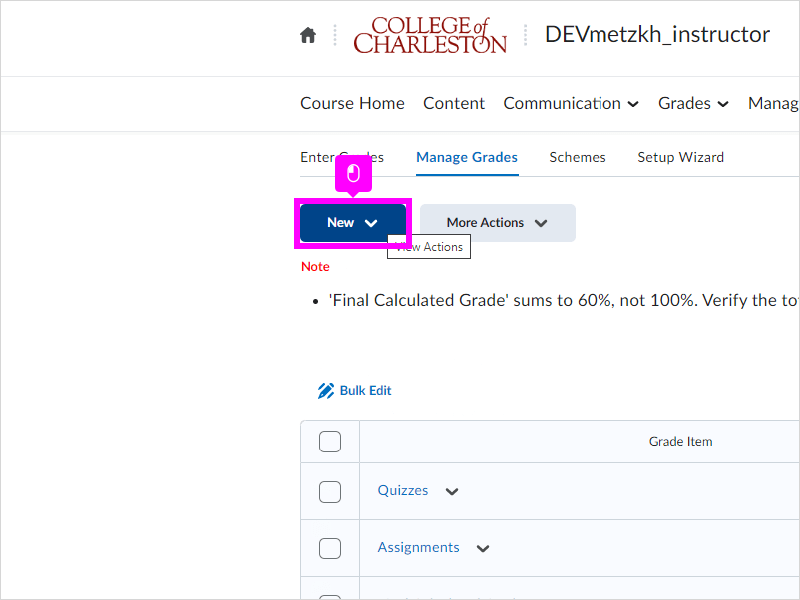
|
|
20. Click Item. Remember creating an item is what creates a column in your gradebook.
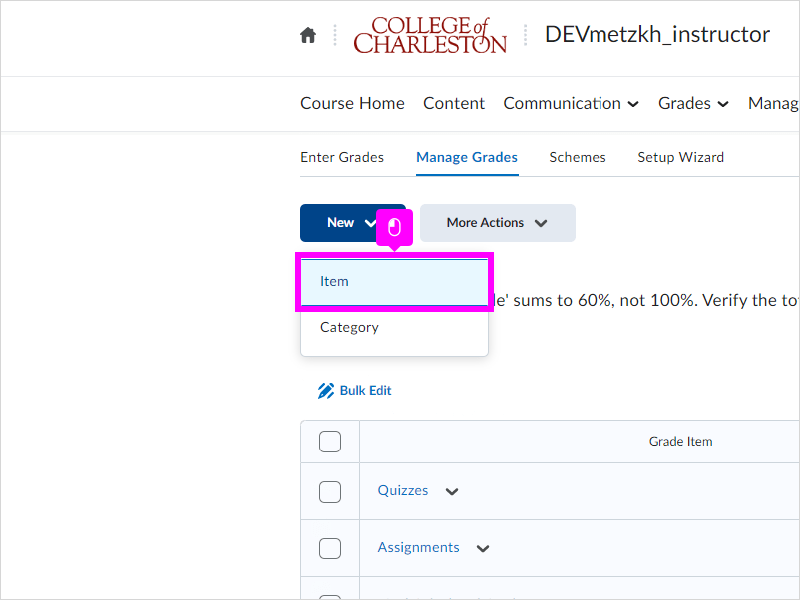
|
|
21. You have to choose what type of item you are working with. Most gradebook items are numeric, so click Numeric.
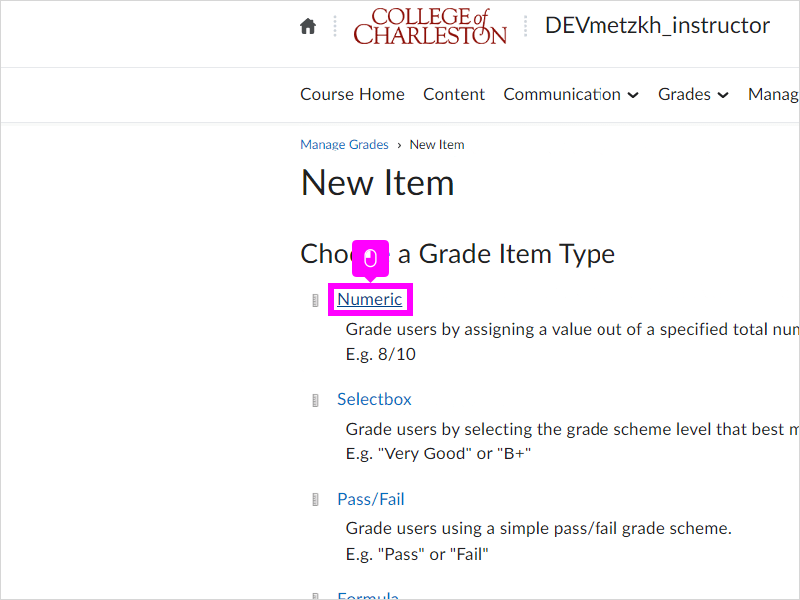
|
|
22. Type a name for the item in the Name field. We'll type midterm exam. The midterm exam is not in a category, so we'll leave that drop down field set to None. You do not need to type a Short Name or Description unless you wanted to.
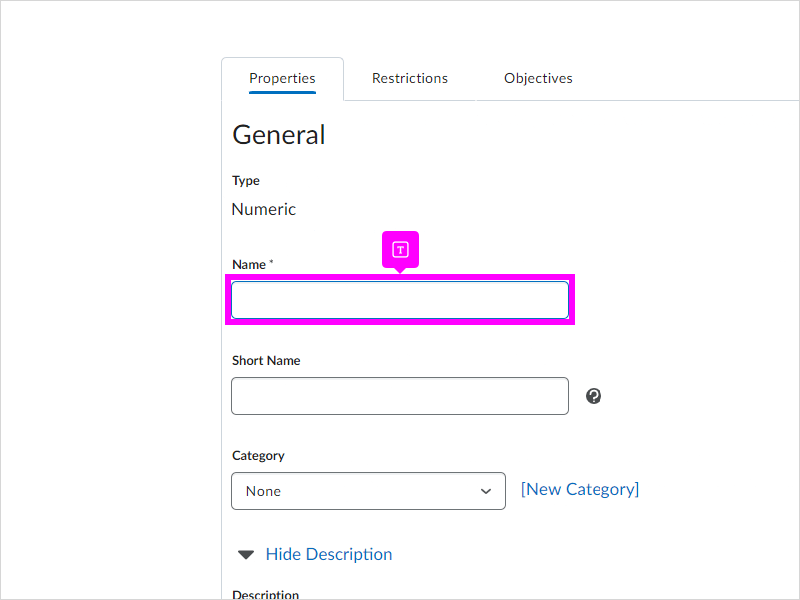
|
|
23. Set the number of points that your assessment is worth. 100 points are often used for every assessment in a weighted gradebook because it is the percentages that you set that determine the weight. Type 100 into the Maximum Points field.
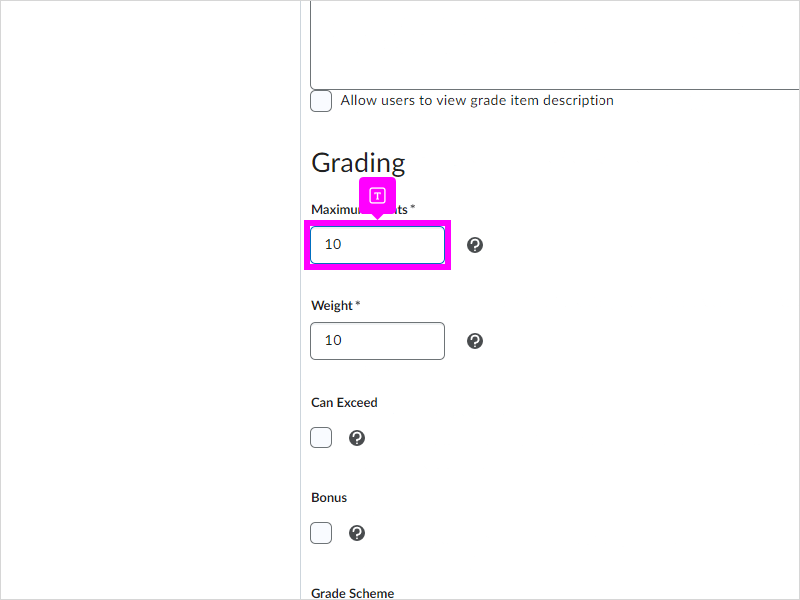
|
|
24. We said the weight for the midterm exam would be 20% so type a 20 into the Weight field.
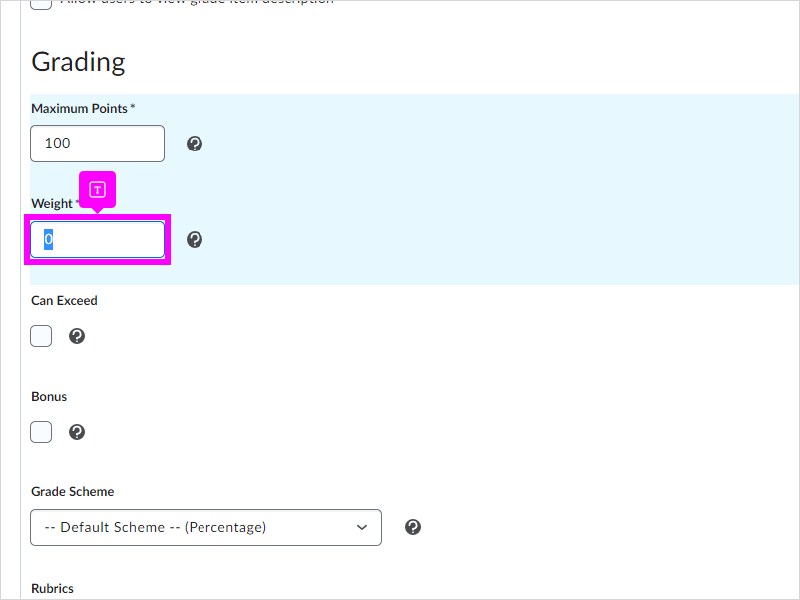
|
|
25. Check 'Can Exceed' if your item could go over 100, like if you had some extra credit question(s) and a student could make over 100. Check 'Bonus' if the entire assignment is extra credit. For this tutorial, we will not check either of those options.
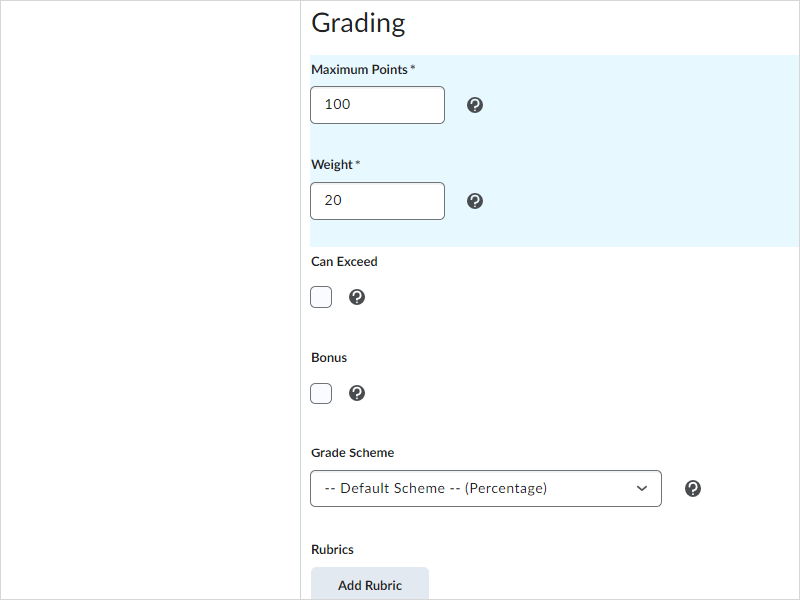
|
|
26. Click Save and New, and then we will add our final exam.
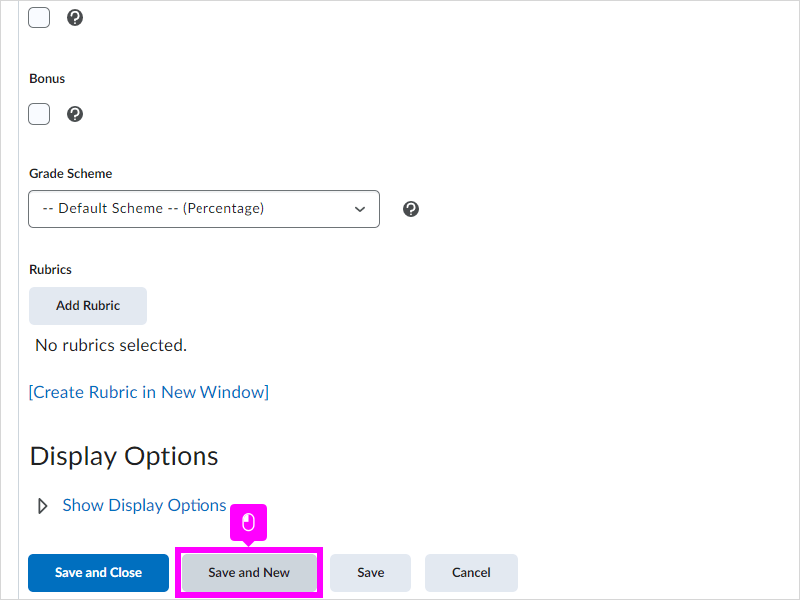
|
|
27. Again, since the final exam is only one grade, we do not have to make a category. Our final exam is also a numeric grade item, so click Numeric.
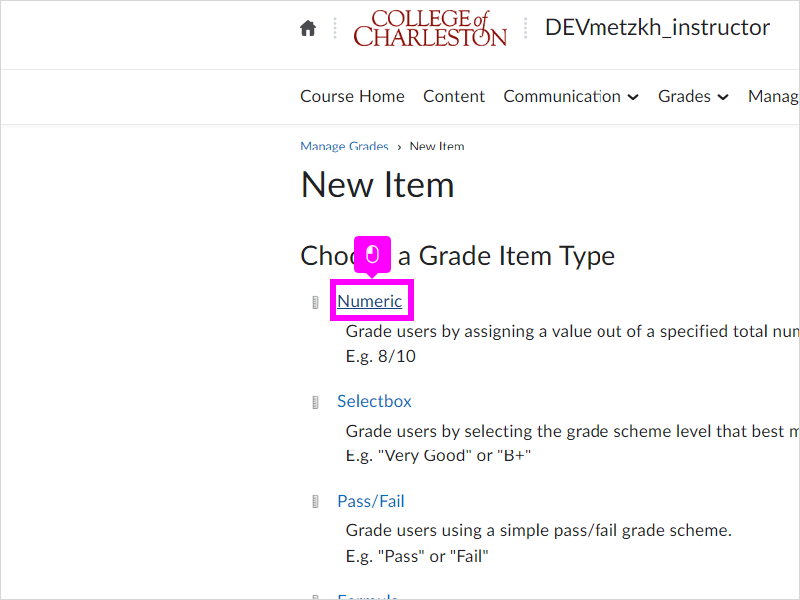
|
|
28. Type in Final Exam into our Name field. You do not need to write anything under Short Name or Description unless you wanted to. Our final exam is not in a category, so we will leave that drop down as None.
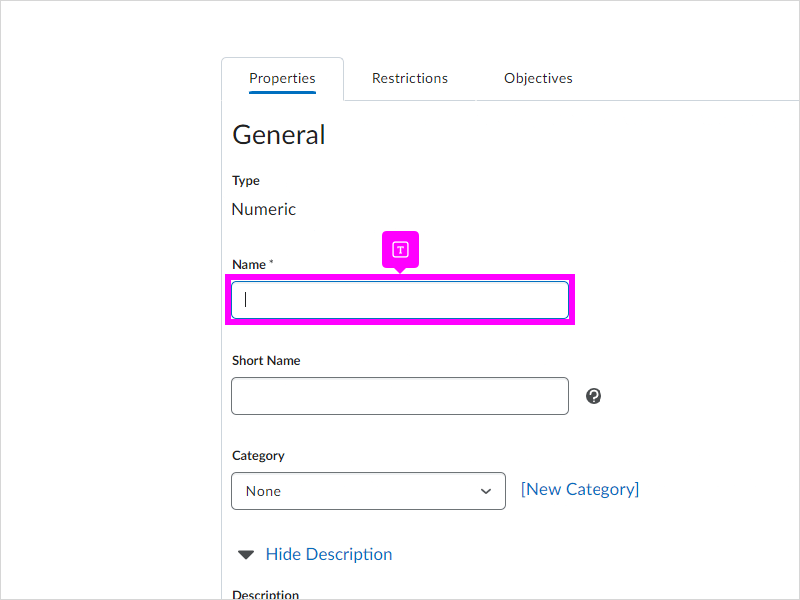
|
|
29. Choose the number of points for the final exam. We will type 100 in the Maximum Points field for this example. In a weighted gradebook, grades are typically graded out of 100 points.
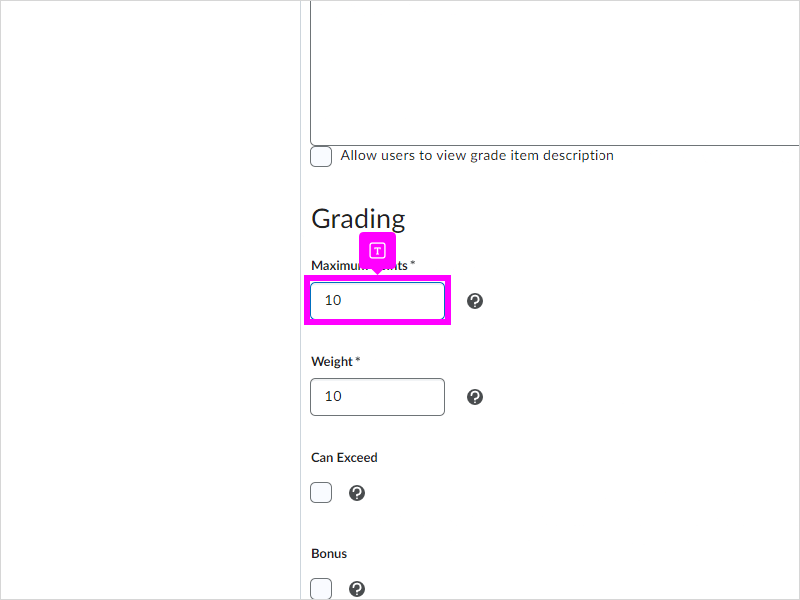
|
|
30. We said our final exam would be worth 20% of our grade, so type 20 into the Weight field.
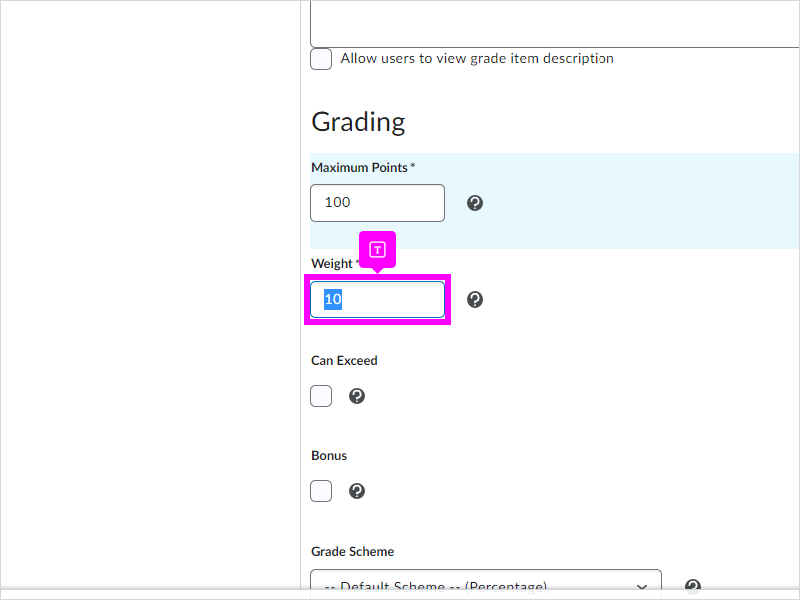
|
|
31. We have put in a category for quizzes and assignments. We have also added the midterm and final exam in as items. Now we need to make items for our quizzes and assignments. Click Save and New to make a new item in the quizzes category.
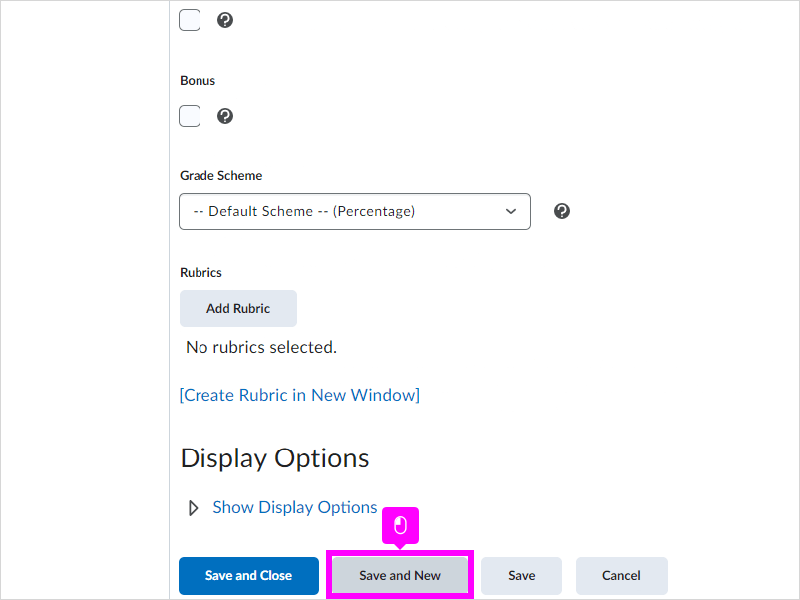
|
|
32. Click on Numeric since our quizzes are a numeric type item.
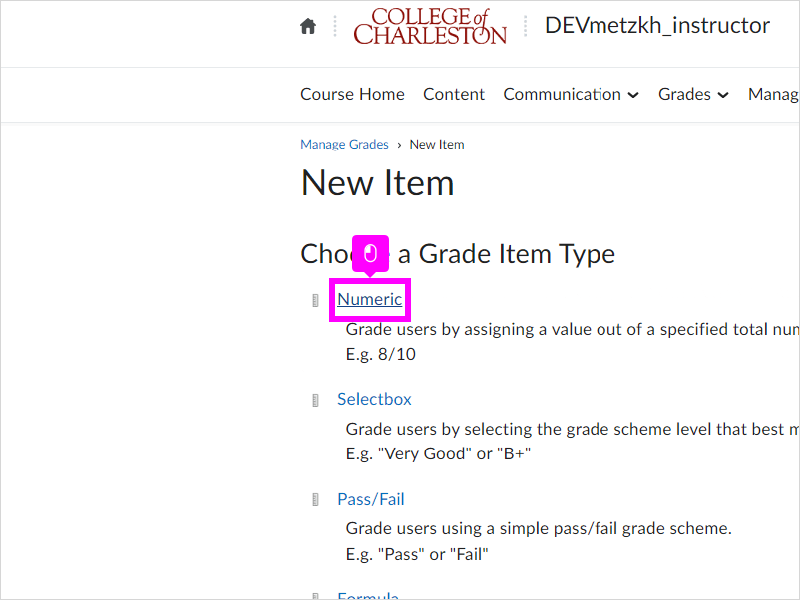
|
|
33. Let's call our first quiz, Quiz 1. Type Quiz 1 in the Name field. You do not need to add a Short Name or Description unless you wanted to.
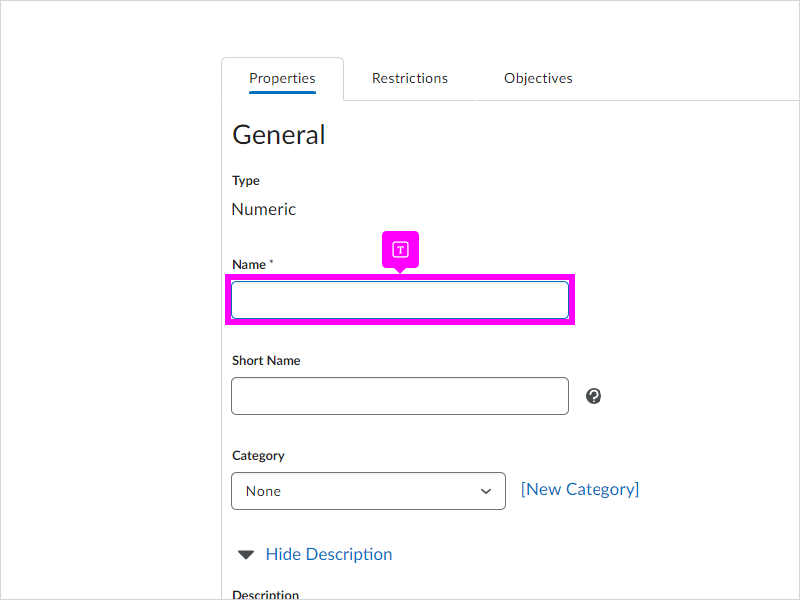
|
|
34. This time, we are making an item that will be in our quiz category so under the Category drop-down, we will select the Quizzes category. Creating an item is what will give us a column in our gradebook to record grades.
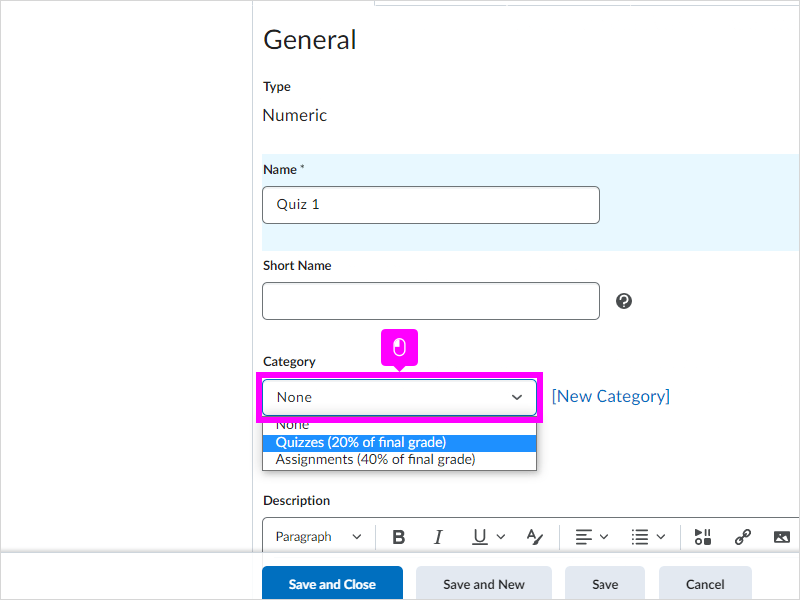
|
|
35. We will grade our quiz out of 100 points so type 100 in the Maximum Points field.
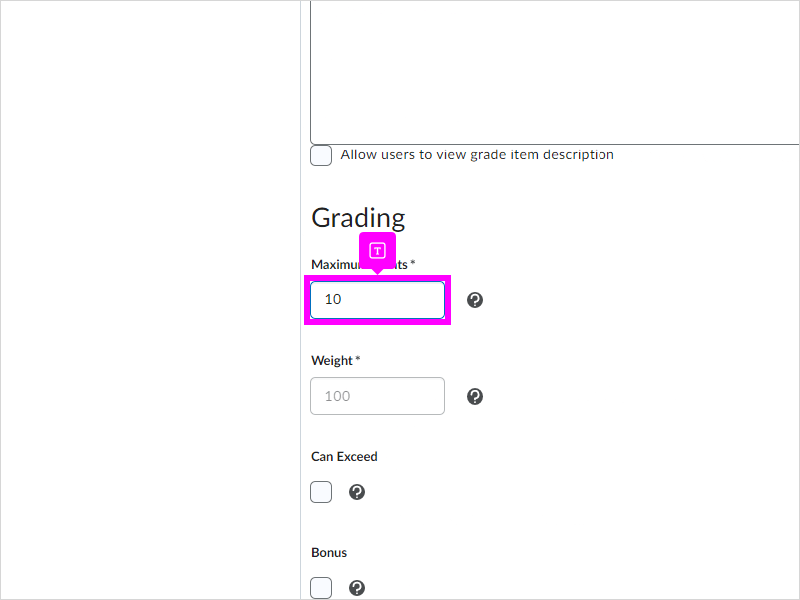
|
|
36. Notice that the weight of this item is set to 100, and you are unable to change it. This is because we already set our Quizzes category to be 20%, but Quiz 1 is the only item in that category right now, so it is weighted 100% of that 20%.
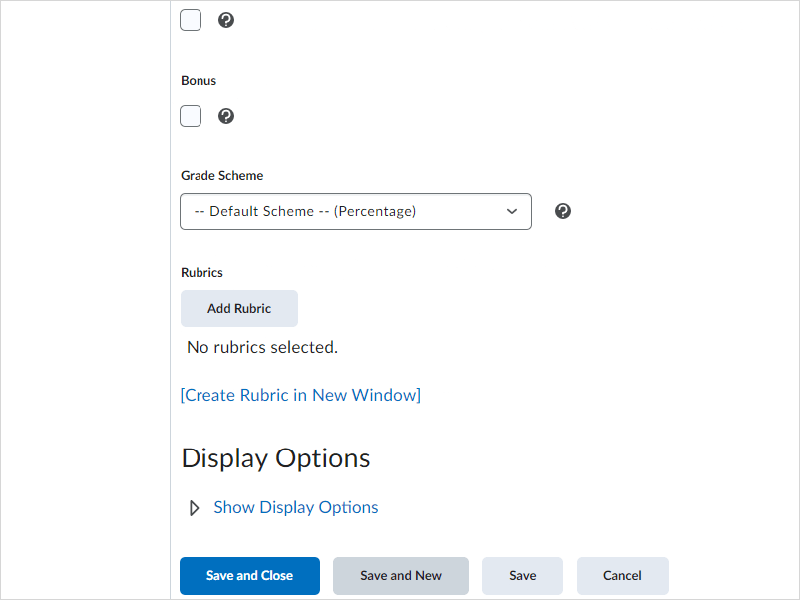
|
|
37. The weight field of your items will change automatically as you add more items. After we add in Quiz 2, the weight of each one will automatically become 50% (of that 20%) since there are 2 quizzes. Click Save and New to add in Quiz 2.
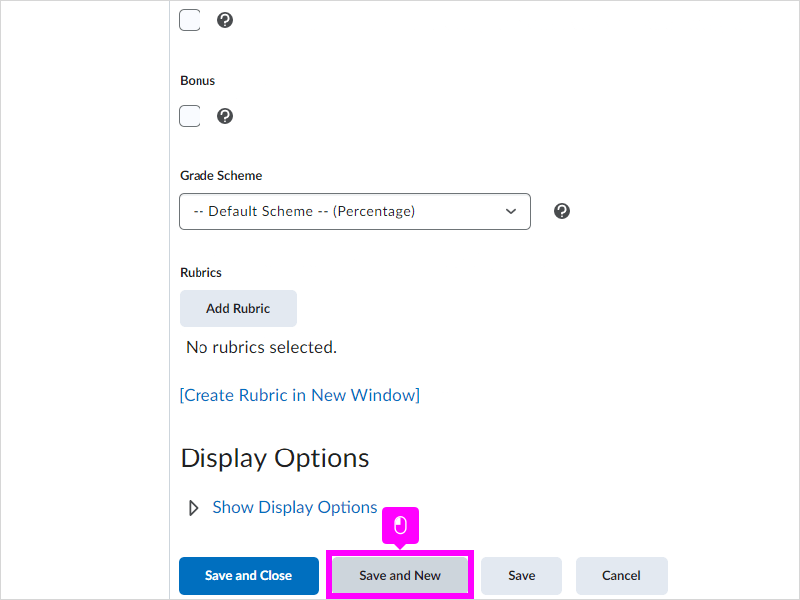
|
|
38. Click on Numeric since our quizzes are a numeric type item.
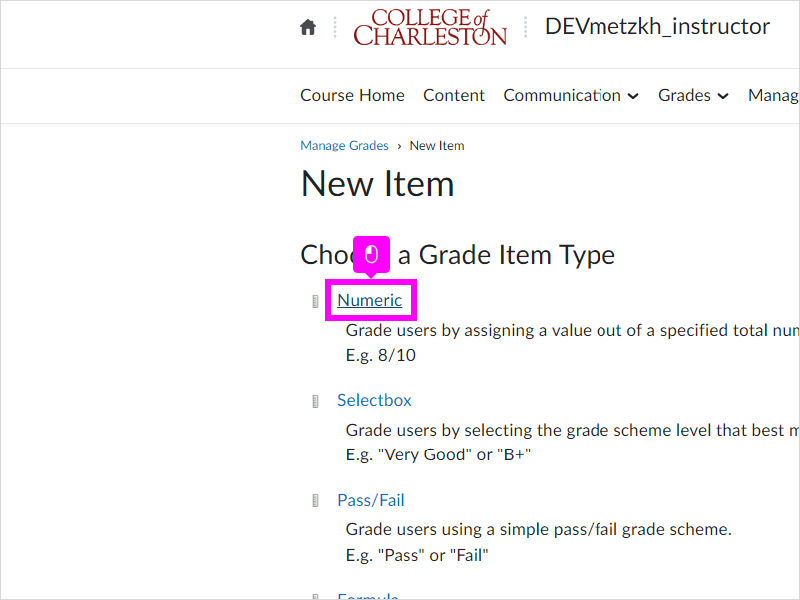
|
|
39. Let's call our second quiz, Quiz 2. Type Quiz 2 in the Name field. You do not need to add a Short Name or Description unless you want to.
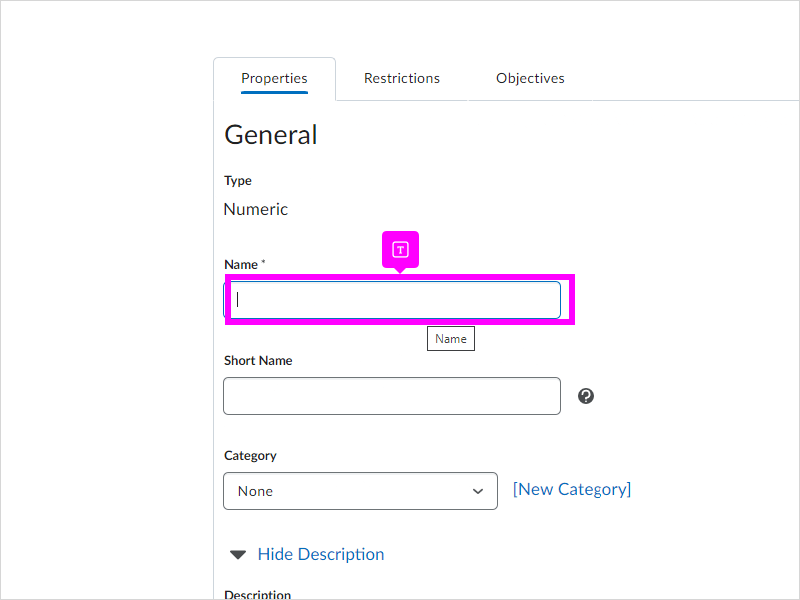
|
|
40. We are making an item that will be in our quiz category so under the Category drop-down, we will select the Quizzes category. Creating an item is what will give us a column in our gradebook to record grades.
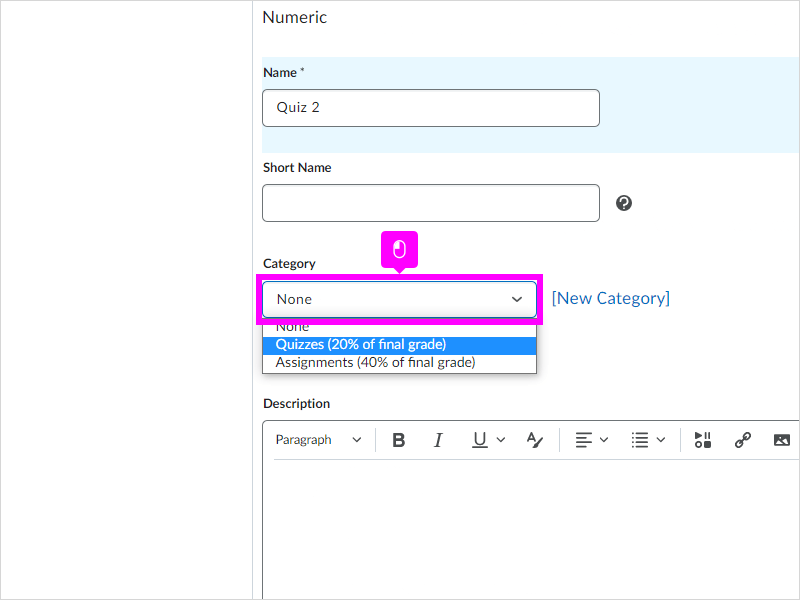
|
|
41. We will grade our quiz out of 100 points so type 100 in the Maximum Points field.
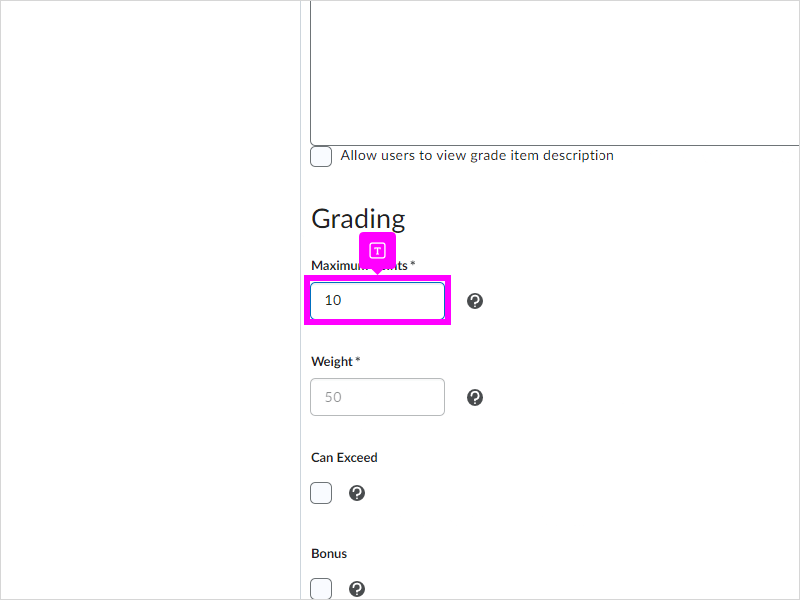
|
|
42. Notice that your weight has automatically changed to 50% (of the 20% total for quizzes) because you have two quizzes. If you went back and looked at Quiz 1 now, you would see that it also now has a weight of 50.
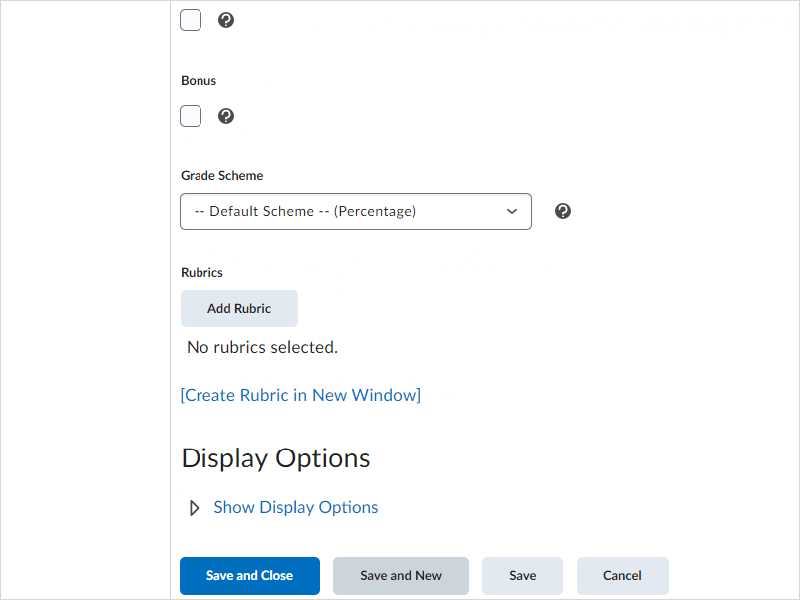
|
|
43. If you wanted to make more quizzes in the Quizzes category, you would continue to add them in the same way. Let's add an Assignment to the Assignments category. Click Save and New to start a new item.
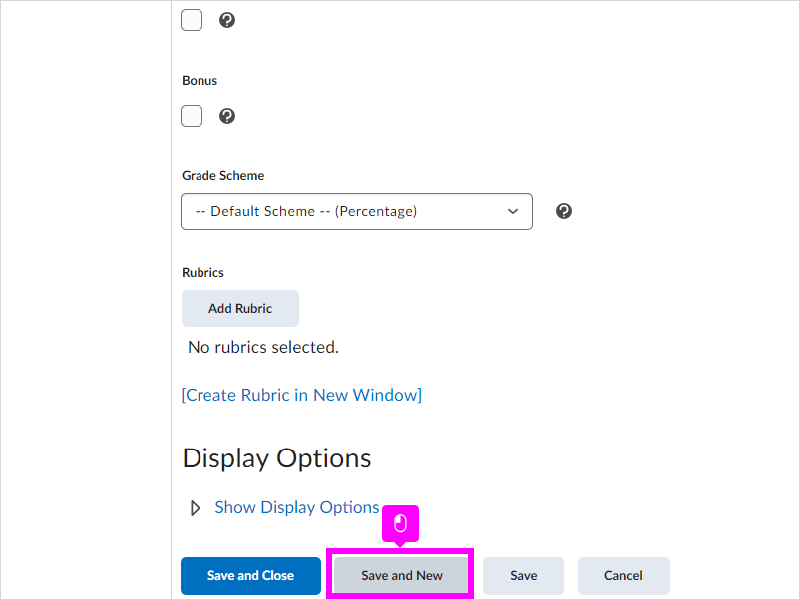
|
|
44. Click Numeric since the Assignment items are a numeric item type.
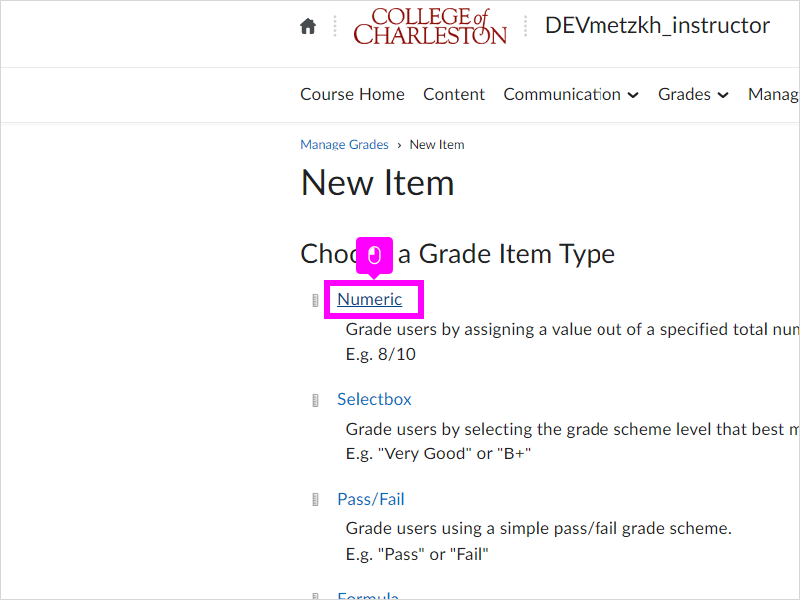
|
|
45. Let's call our first assignment Chapter 1 questions. Type Chapter 1 questions in the Name field. You do not need to complete the Short Name or Description fields unless you wanted to.
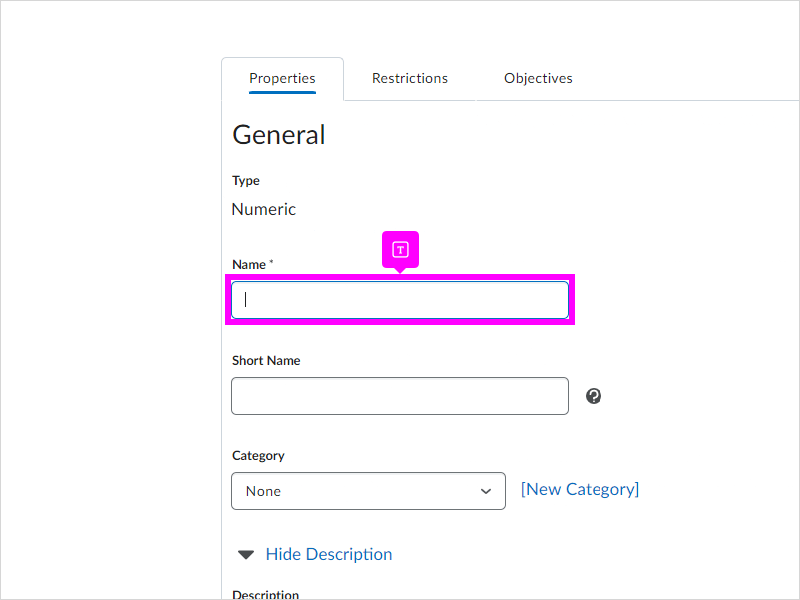
|
|
46. What will you choose in the Category drop-down this time? That's right! Assignments! We are putting the item Chapter 1 Questions in the Assignments category.
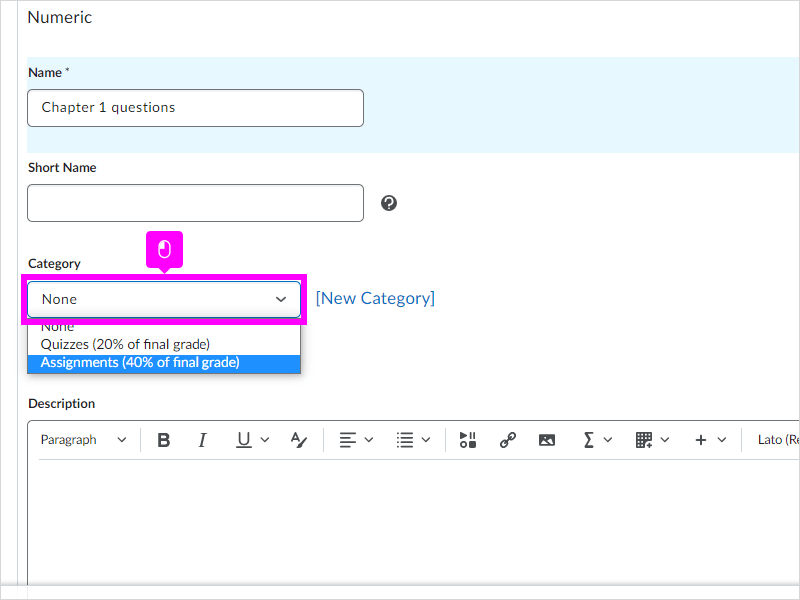
|
|
47. We will grade our quiz out of 100 points so type 100 in the Maximum Points field.
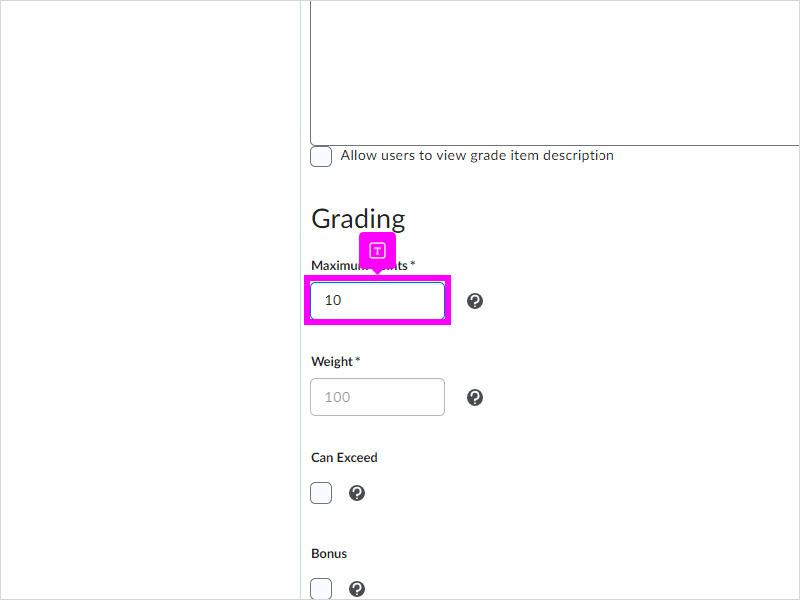
|
|
48. If you wanted to add more items, you could click Save and New and repeat the same process until you added all of your items. We will click Save and Close because we are not going to add any more items in this tutorial.
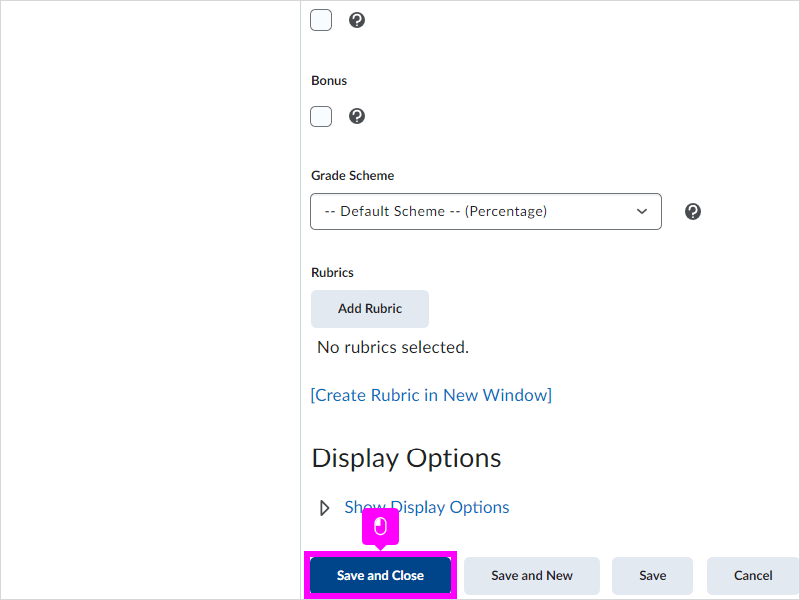
|
|
49. Under Manage Grades, you can view all of your items and see how they are in their categories. If there are any that you made a mistake on, you can always do the drop-down menu beside the item/category and edit the properties.
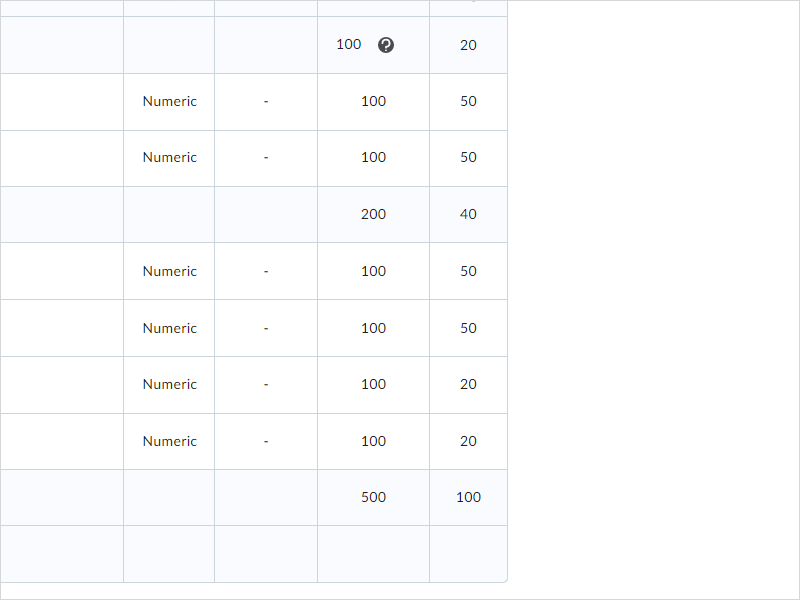
|
|
50. Notice how our gradebook weights add up to 100. The quizzes have a weight of 20, the assignments have a weight of 40, the midterm has a weight of 20, and the final has a weight of 20. Your overall gradebook must always equal 100.
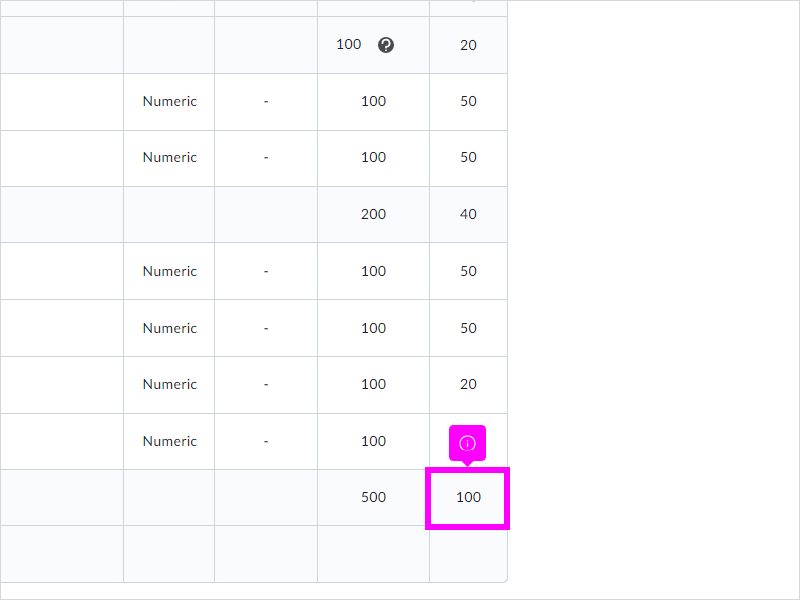
|
|
51. We have gone over how to create categories with weighted percentages as well as how to add items that will give you a gradebook column to record grades in. You will be able to complete a similar process for your own gradebook in your own OAKS class.
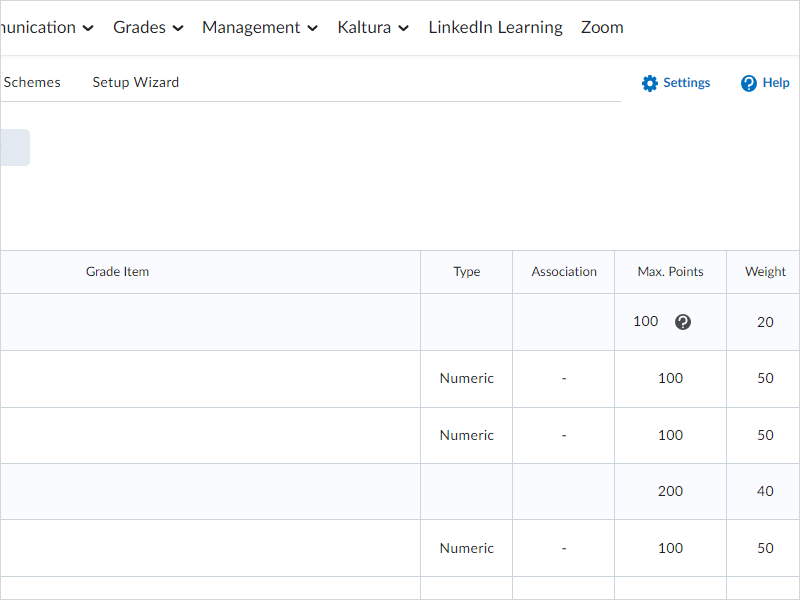
|